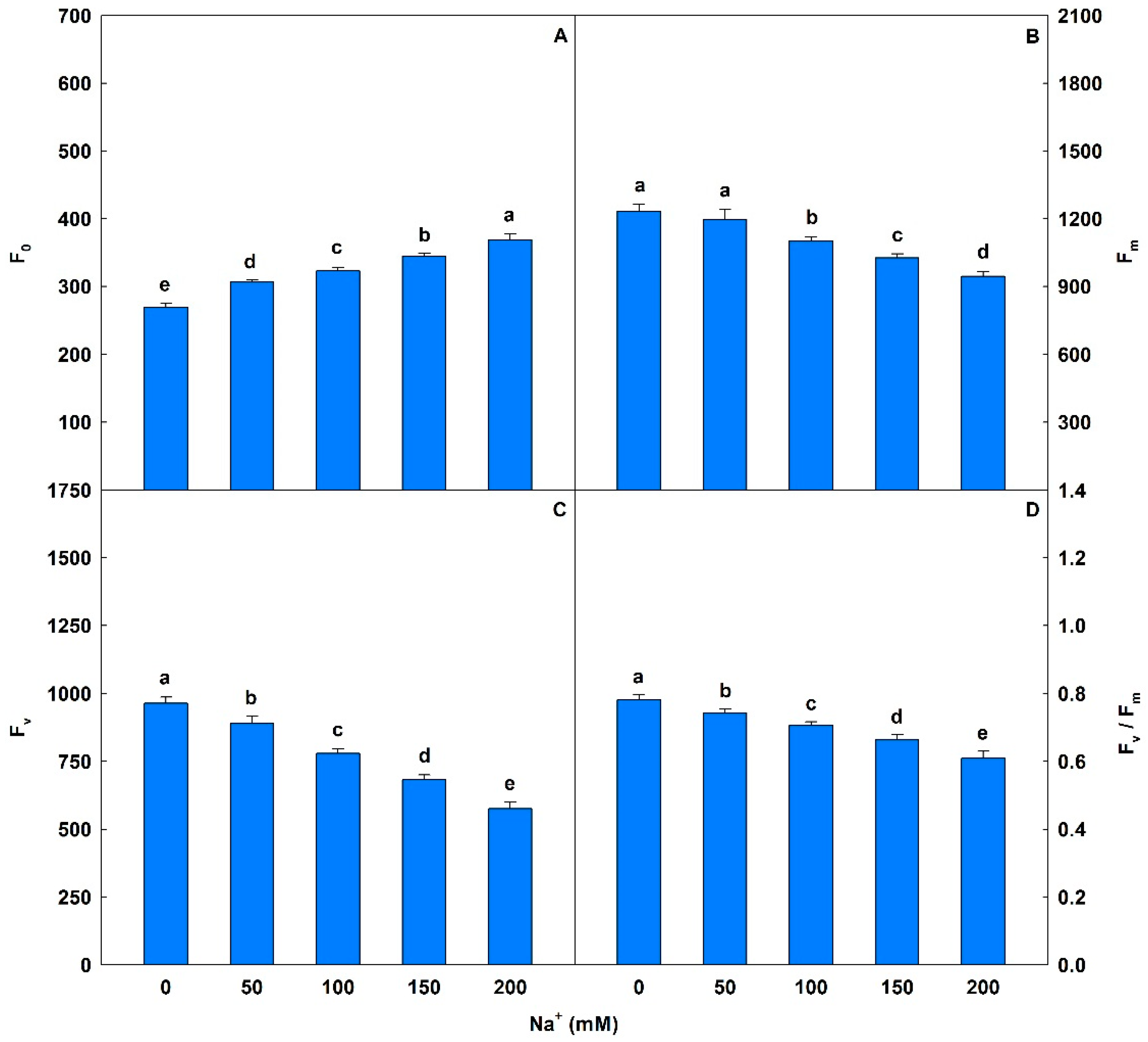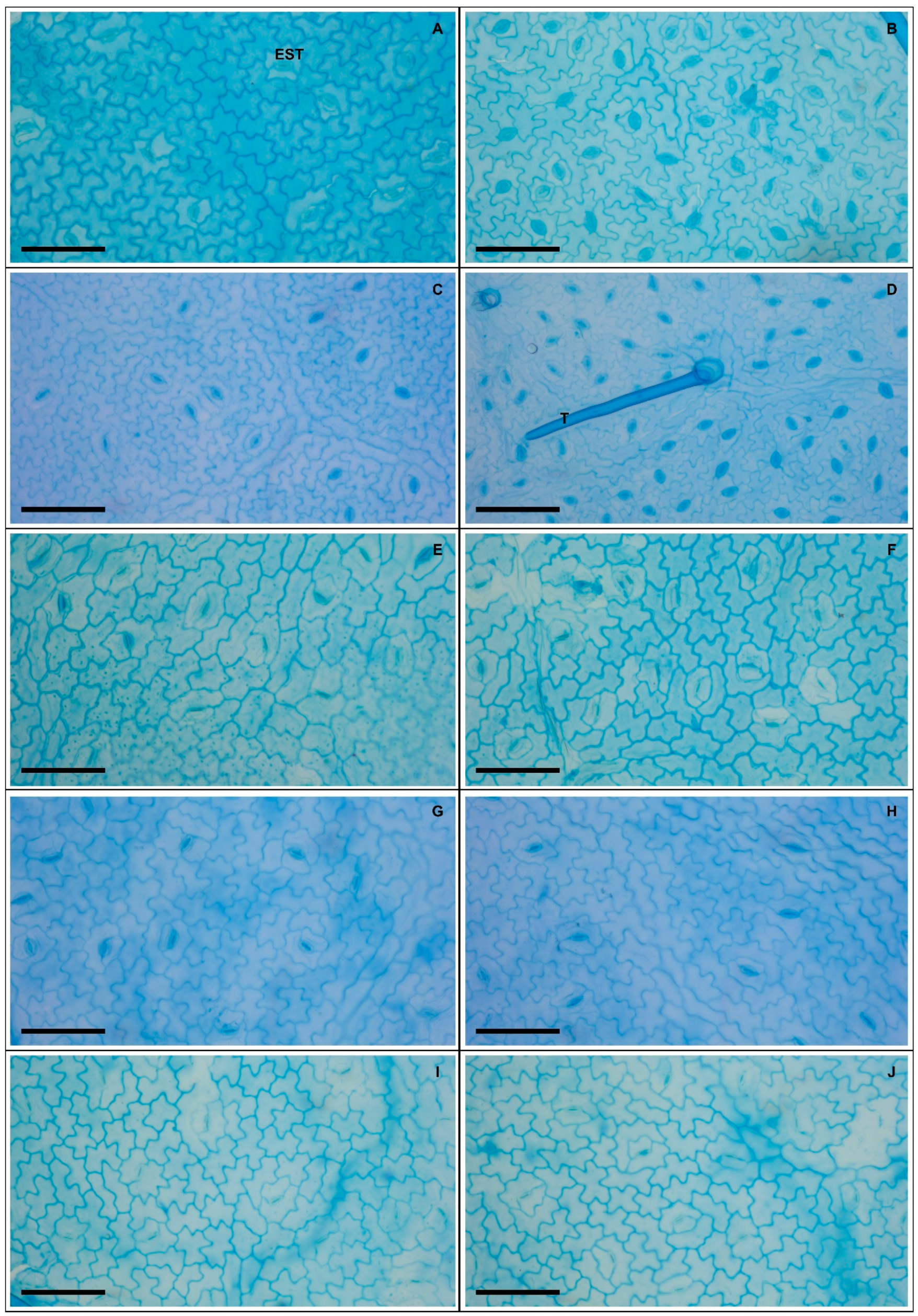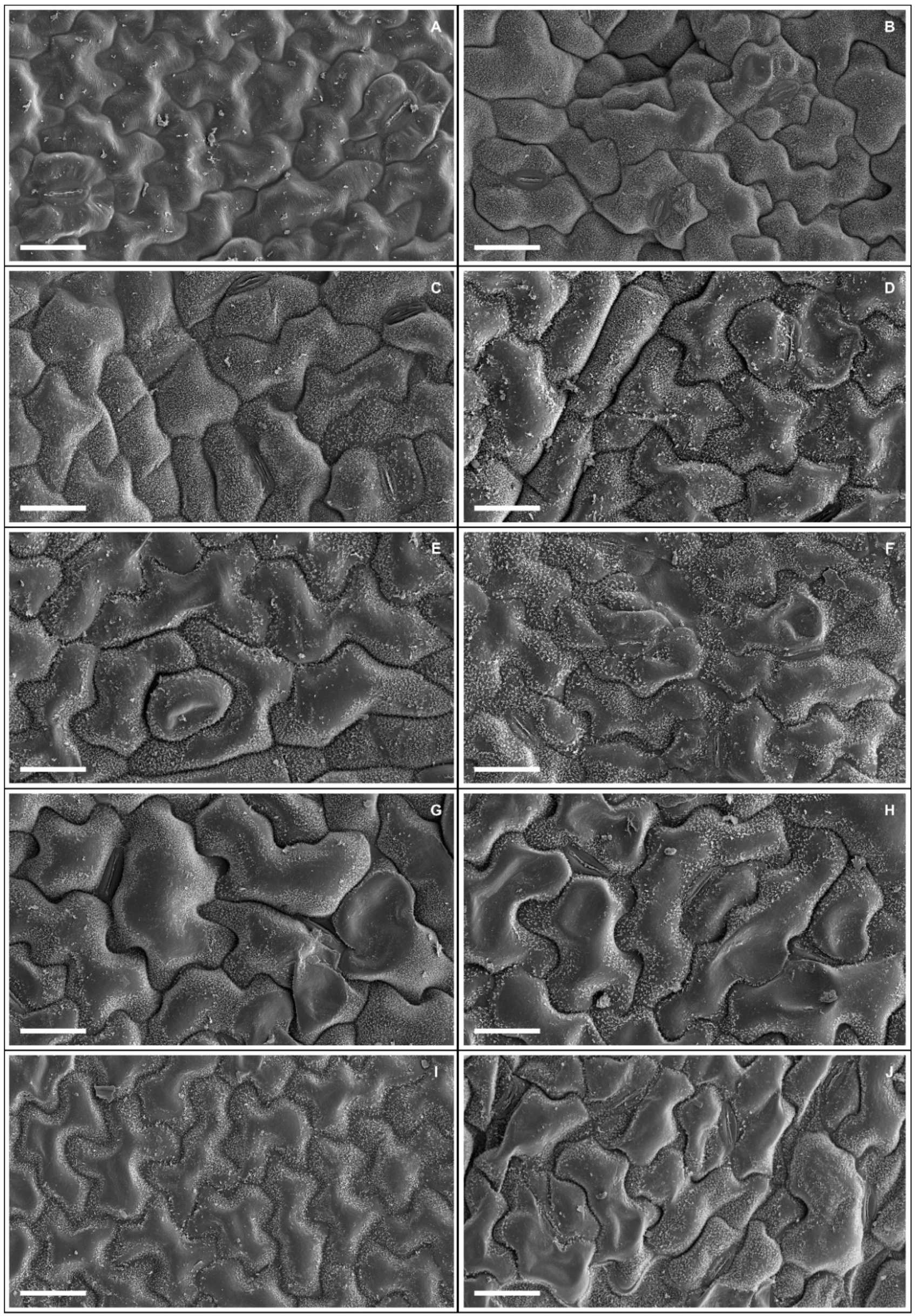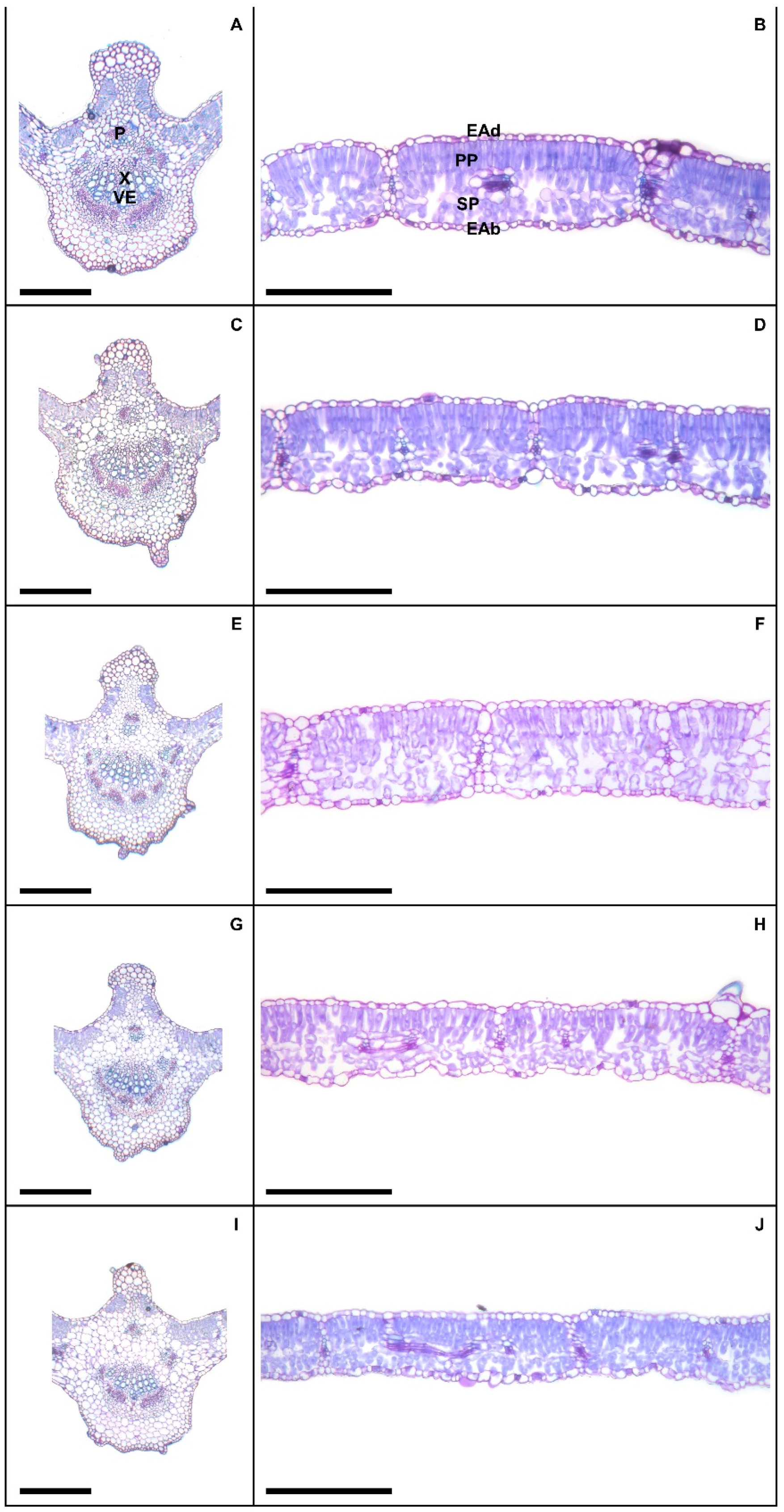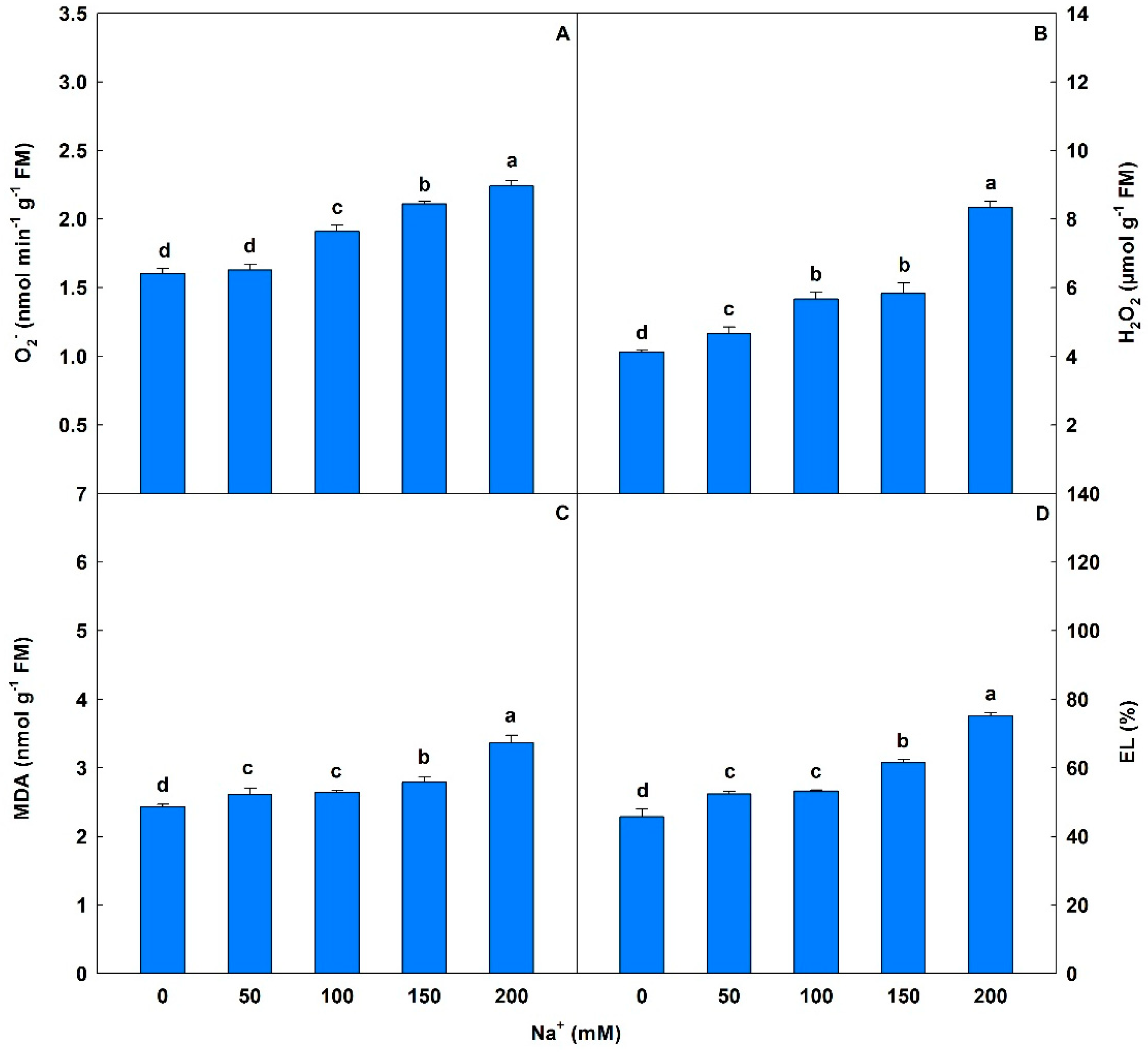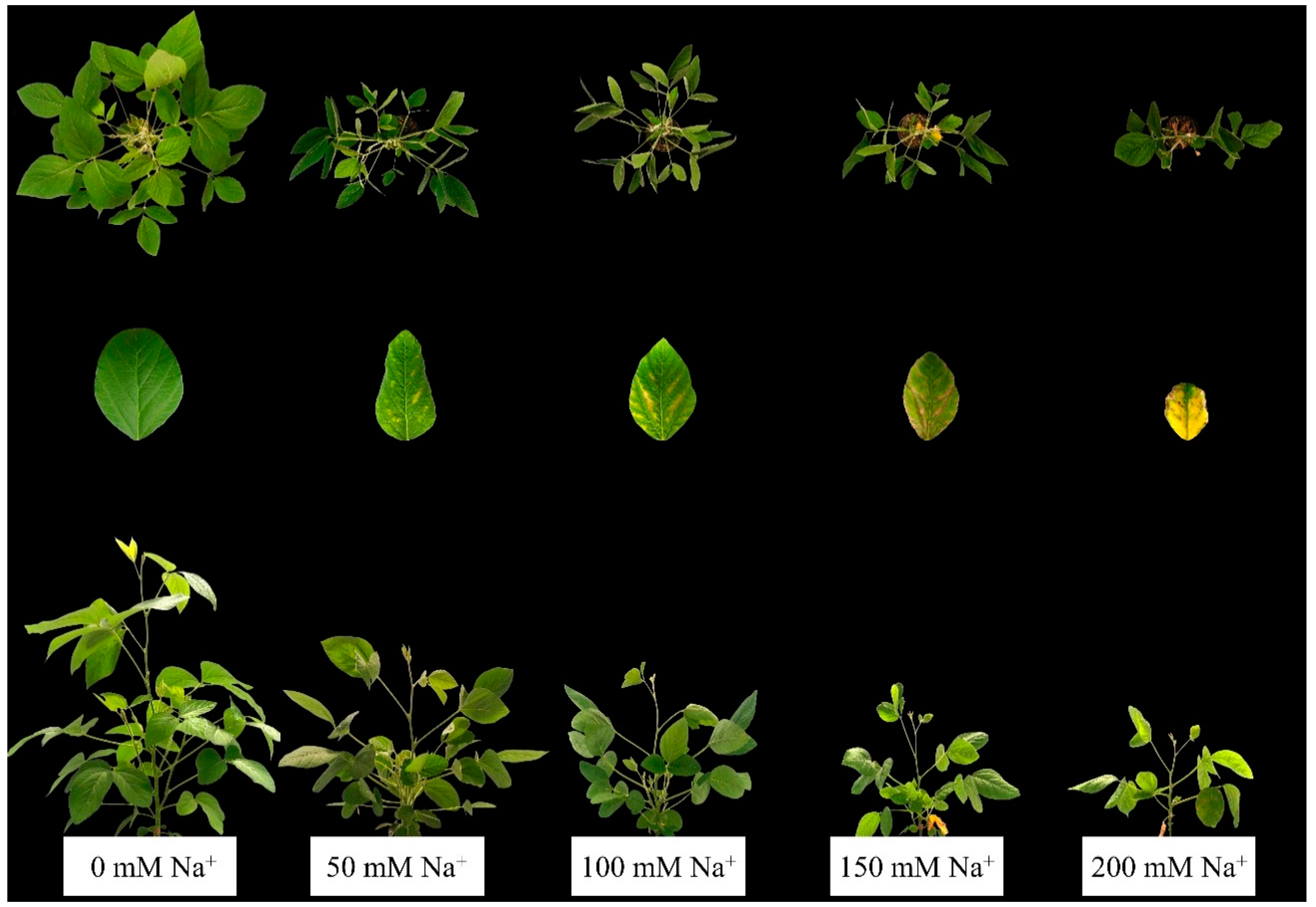1. Introduction
Soybean (
Glycine max (L.) Merr.) is one of the most important crops in the world because its seeds are rich in oils and proteins [
1] that can be used in foods, animal feed [
2], and as an energy source in biofuels [
3]. Global production is estimated at approximately 338 million tons, with the United States being the main producer, followed by Brazil and Argentina. However, one of the main factors limiting soybean cultivation is soil salinity [
4], a matter of increasing importance since approximately 800 million hectares of land are affected by this environmental problem.
Salinity is one of the main forms of abiotic stress, occurring mainly in arid and semi-arid regions that experience low precipitation and high evapotranspiration [
5]. However, anthropogenic factors may exacerbate and potentiate salt accumulation via inadequate irrigation, poorly drained soils, and overuse of fertilizers and pesticides [
6]. Among the salts that accumulate in soils and which are harmful to agricultural crops, NaCl stands out, and in recent years it has been the focus of numerous studies on its effects on plants [
7,
8,
9,
10].
Soil salinity tends to cause the accumulation of Na
+ ions inside plant cell vacuoles [
11]. This causes an osmotic imbalance by decreasing the soil water potential and reducing a plant’s ability to take up water [
12], making the Na
+ potentially toxic through metabolic disturbance [
13]. Furthermore, the osmotic pressure caused by excess Na
+ in the growth regions adversely affects ionic balance, delaying the transport and accumulation of macro- and micronutrients in plant tissues [
4]. Stress arising from raised Na
+ concentration is often accompanied by the replacement of K
+ by Na
+ in cytosol, and since K
+ acts as an enzymatic cofactor and is involved in protein synthesis this may alter biochemical reactions and protein conformation [
14].
Plants develop morphological, physiological, biochemical, and anatomical strategies to tolerate salt stress, including the selective exclusion of ions, ionic accumulation in root structures that reduces ion transport to leaves, compartmentalization of ions in vacuoles, biosynthesis of osmoregulators, modulation in gas exchange, and increasing the activities of antioxidant enzymes [
15,
16].
Na
+ stress can be classified as mild, moderate, or severe, depending on exposure time and salt concentration. Plants exposed to mild and moderate Na
+ concentrations exhibit structural changes in leaf epidermis, more specifically an increase in leaf hairiness [
17] and epicuticular wax accumulation [
18], as a strategy to prevent damage connected to light and temperature as well as to avoid excessive transpiration through stomata guard cells [
19]. Severe Na
+ exposure induces ionic toxicity and overaccumulation of ROS, causing oxidative stress and hormonal imbalance [
20], with negative repercussions on photosynthetic pigments, growth rate, and biomass accumulation [
21].
Our hypothesis investigated the problems caused by different Na+ concentrations on morphological aspects in soybean plants; we considered that a multidisciplinary, broad, and comparative approach was essential to explain the deleterious effects. On this basis, our research measured anatomical, nutritional, physiological, and biochemical interferences, detailing possible consequences on morphological responses in soybean plants subjected to progressive salt stress.
4. Discussion
The increases in Na
+ content in soybean leaf tissues observed in this study confirm the aim of simulated salt stress. High concentrations of salts, mainly Na
+, interfere with K
+ uptake due to the high affinity of Na
+ for transporters and non-selective cationic channels [
44] resulting in reduced K
+ content and K
+/Na
+ ratio in leaves after salt stress. Imbalances connected to K
+ absorption often cause metabolic disturbances, including loss in enzyme activities and protein synthesis, and negatively affect the photosynthetic process, cell expansion, and stomatal movements [
45]. Na
+ accumulation in the stem is a strategy employed by plants to reduce osmotic and ionic stresses in leaf tissue, leaves generally being more sensitive to the stress caused by Na
+ [
46]. Silva et al. [
47] evaluating anatomical changes in stem and root of
G. max submitted to progressive concentrations from 0 to 200 mM NaCl detected a higher accumulation of Na
+ in the stem. Tiwari et al. [
48] evaluating 17 genotypes of
Cucumis sativus at four salinity levels found increases in Na
+ content and decreases in both K
+ content and K
+/Na
+ ratio in the leaves of all analyzed genotypes. Ding et al. [
49] investigating the growth, antioxidant system, and the nutritional content in
Solanum melongena leaves exposed to 90 mM NaCl verified significant increases in Na
+ content and decreases in K
+ concentration and K
+/Na
+ ratio, respectively.
In this study, salinity induced reductions in the content of macronutrients (Ca, Mg, and S) and micronutrients (Fe, Mn, and Cu). Reductions in these nutrients are associated with high salt concentrations that increase osmotic pressure mainly in plant growth regions, interfering with the uptake of water and nutrients [
15]. Na
+ stress maximizes competition between ions, delaying the mobility and accumulation of essential nutrients in plant tissues [
4]. High concentrations of Na
+ cause replacement of Ca
2+ in membranes leading to a decrease in K
+/Na
+ selectivity [
50] and a weakening of the cell wall structure making it more susceptible to rupture [
51]. Reduced concentration of K
+ and Ca
2+ ions in tissues caused by salt stress often reduces plant growth [
52]. Ca
2+ is the second most used intracellular messenger in plants [
53]. When extracellular stress signals are perceived by membrane receptors, Ca
2+ acts as an intracellular messenger, inducing tolerance mechanisms, including reduction in plant growth, apoptosis and Na
+ translocation into the cells of older tissues [
54]. Morgan et al. [
55] evaluating ionic homeostasis and ATPase activities in
Vicia faba exposed to 100 mM NaCl during two harvest periods (7 and 14 days) found reductions in the Ca
2+ content. Similarly, Teixeira and Carvalho [
56] evaluating the salt stress (0, 60, 120, and 240 mM NaCl) on the mineral composition of
Portulaca oleracea found reductions of up to 56% and 81% in the Ca
2+ content of plants sown in spring and summer, respectively.
As with K
+ and Ca
2+, a decrease in Mg
2+ in plant tissues may occur under saline conditions due to Na
+ interference [
57]. Mg is a central element in the chlorophyll molecule, and participates in several enzymatic processes that involve phosphate transfer [
58]. The reduction in the tissue Mg
2+ content may have contributed to the decrease in the photosynthetic pigments observed in this study. Another nutrient that plays an important role in the proper function of the photosynthetic apparatus and in the electron transport system is sulfur (S). Sulfur-containing compounds are also involved in ROS metabolism, where they contribute to mitigating salt-induced oxidative stress and improving ionic selectivity linked to K
+ and Na
+ [
59]. On the other hand, S deficiency negatively impacts plant metabolism, decreasing the chlorophyll content and photosynthetic efficiency, and altering the activity of ribulose-1,5-bisphosphate carboxylase-oxygenase (RuBisCO) [
60]. Bendaly et al. [
61] evaluating physiological and biochemical changes in
Atriplex halimus plants exposed to progressive salinity (0 to 400 mM NaCl) observed reductions in Mg
2+ content at the higher salt concentrations. When studying the effect of 35 mM NaCl on an F6 cultivar of
Fragaria × ananassa, Karlidag et al. [
62] found reductions of 75% and 47% in the content of Mg and S, respectively.
In general, micronutrients are negatively impacted by Na
+ because they are involved in the constitution, integrity, and function of several plant organelles [
63]. Fe is an important and essential micronutrient for chlorophyll biosynthesis and in antioxidant enzyme activity, directly acting on photosynthesis and cellular respiration [
64]. Mn also plays important roles in plant metabolism, participating in photosynthesis, constituting the PSII proteins, and activating decarboxylase, dehydrogenase, peroxidase, and phosphatase [
65]. Mn deficiency inhibits growth and induces chlorosis, necrosis, and cell death [
66]. Cu is highly affected by salinity and reduced absorption of this micronutrient can cause leaf damage, including significant reductions in chlorophyll pigments and photosynthesis, impairing electron transport activity in PSII [
67]. When analyzing the nutritional content of
Cucumis sativus plants subjected to salinity, Huang et al. [
68] reported reductions of 69%, 73%, and 65% in Fe, Mn, and Cu content, respectively. Oliveira et al. [
10] evaluating the morphological, physiological and biochemical impacts in
Eucalyptus urophylla seedlings exposed to 250 mM NaCl found a 59% reduction in Fe content.
Na
+ induced progressive increases in F
0 values, indicating that this ion decreased the proportion of oxidized quinone (Q
A) and negatively affected the efficiency of the capture of light energy in the PSII reaction center [
69]. Reductions in F
m, F
v and F
v/F
m values after saline stress reveal a deficiency in the conversion of photochemical energy, with possible photoinhibition or damage to the PSII complex [
70]. Additionally, salt stress impairs the structure and organization of the thylakoid membrane, often causing decreases in the photosynthetic activity in the reaction centers [
71]. Khoshbakht et al. [
72] evaluating the parameters of chlorophyll fluorescence in
Citrus reticulata × Citrus limetta seedlings submitted to 75 mM NaCl, observed increases in F
0 values and reductions in F
m, F
v, and F
v/F
m. Stepien and Johnson [
73] studying the photosynthetic responses in
Arabidopsis thaliana exposed to 100 and 150 mM NaCl found reductions in F
v/F
m values.
Plants exposed to concentrations of 50 to 200 mM Na
+ exhibited decreases in Φ
PSII, q
P, and ETR values, demonstrating a lower energy absorption of photons and subsequent decrease in energy flow for excitation of electrons captured by plastoquinone [
74], while increases in NPQ, EXC, and ETR/
PN values suggest mechanisms of protection against PSII damage, including higher thermal dissipation in the reaction center [
75] and increased photorespiration through the consumption of photochemical energy [
76]. Yuan et al. [
77], evaluating the photosynthetic performance and heat dissipation capacity in
Cucumis sativus plants subjected to 75 mM NaCl, observed decreases of 35% in values of both Φ
PSII and q
P. Yan et al. [
78] detected negative changes in photosynthesis and efficiency of PSII in
Caragana korshinskii leaves exposed to three levels of salinity (0, 100, and 300 mM NaCl), with increased NPQ values and reduced Φ
PSII, q
P, and ETR after 1, 9, and 18 days of salt stress. Aragão et al. [
79] studying
Jatropha curcas plants exposed to 100 mM NaCl detected decreases in q
P (28%) and ETR (36%), as well as increases in NPQ (200%), EXC (120%), and ETR/
PN (42%).
Negative effects on
PN,
E, and
gs were observed in plants exposed to salinity. The adverse osmotic conditions induced by the Na
+ stress probably stimulated abscisic acid (ABA) biosynthesis, acting on stomatal closure and negatively influencing
gs values [
16]. Additionally, stomata-related limitations, evidenced by reductions in SD, SI, and SF, impair
E and CO
2 influx, inducing reductions in
PN [
80]. In other words, the reductions in
E and
PN, coupled with the low performance in stomatal regulation (
gs) justify the reduction detected in WUE and the clear limitations on gas exchange. Agrawal et al. [
81], evaluating growth, gas exchange, and ionic regulation in two
Ziziphus mauritiana cultivars subjected to NaCl (electrical conductivity from 0 to 16 dS m
−1), observed decreases in
PN,
gs, and
E values. Physiological responses similar to those found in our research were found by Zheng et al. [
82] comparing the performance of two
Triticum aestivum genotypes exposed to 50, 100, and 150 mM Na
+, resulting in reductions in
PN and
gs. Shahbaz et al. [
7], evaluating the repercussions of salt stress on growth, photosynthetic capacity, and ion accumulation in eight
Helianthus annuus cultivars, found reductions in WUE.
The increases we observed in
PN/
Ci in plants exposed to 50 to 200 mM Na
+ indicate a decrease in RuBisCO enzyme activity, compromising CO
2 fixation in the Calvin–Benson cycle leading to an increase in
Ci [
83]. Rodrigues et al. [
84], evaluating the physiological adjustment of
Ricinus communis plants under concentrations of 50, 100, and 150 mM NaCl, reported increases in
PN/
Ci values. Chen et al. [
85] observed increases in
Ci after comparing the progressive effects of salinity (40 to 200 mM NaCl) on growth and photosynthetic attributes in
Populus bonatii cultivars.
There were slight increases in SD and SI at concentrations of 50 and 100 mM Na
+, which can be explained by decreases in epidermal cell expansion and leaf area [
86]. On the other hand, SD and SI decreased at 150 and 200 mM NaCl, negatively affecting CO
2 absorption and consequently g
s values [
87]. The oscillations in values for PDS, EDS, and SF indicated that the salt stress influenced the stomata structurally, inducing in fact an elliptic form. Khan et al. [
88] stated that elliptical stomata have better functionality than those with circular form. Decreases in TS and TD values (50 to 200 mM Na
+) were attributed to two effects combined; salt stress and higher sun exposure on epidermal cells, favoring water losses via transpiration [
89]. Barbieri et al. [
19] comparing two
Ocimum basilicum cultivars grown in concentrations of 100 and 200 mM NaCl showed reductions in SD values. Sarabi et al. [
90] studying
Cu. melo plants subjected to 30, 60, and 90 mM Na
+ observed successive decreases in TS and TD values.
The slight increase in EWL observed at 50 mM NaCl has the effect of improving the reflection of radiation incident on the epidermis, protecting against excessive transpiration and respiration, and consequently decreasing the leaf temperature [
91]. However, above 100 mM NaCl there is a degradation of epicuticular wax that may be correlated with Na
+ and Cl
− accumulation in the leaves [
18]. Avestan et al. [
92] studying
F. ananassa (exposed to 25 and 50 mM NaCl) observed changes in leaf structure and reduced EWL.
The anatomical changes in the vascular bundles and the reduction in LXT and LPT values observed under 200 mM Na
+ clearly affected solute translocation by the conductive tissues and reduced photo-assimilate accumulation [
93]. Slight increases in ETAd and ETAb in plants exposed to up to 100 mM Na
+ suggested an anatomical adaptation to salinity that prevents excessive water loss during transpiration [
94]. On the other hand, the observed reduction in these parameters above 150 mM NaCl may indicate susceptibility to damage caused at higher levels of salinity. The decreases in PPT and SPT (200 mM Na
+) may have contributed to the decreases in
PN,
Ci, and
PN/
Ci values; the palisade parenchyma presents the greatest number of chloroplasts, the organelles responsible for the photosynthetic process, while SPT is related to intense formation of intercellular spaces involved with gas exchange [
95]. Moreover, the loose cellular arrangement found in the mesophyll impairs the cell surface contact and consequently the capture of light energy and gas exchange necessary during the photosynthetic process [
96]. Paz et al. [
97] subjected
Lotus tenuis plants to a solution containing 90 mM NaCl and found increases in ETAd, ETAb, PPT, and SPT values.
Plants exposed to salinity (>50 mM Na
+) showed increases in SOD, CAT, APX, and POX activities, demonstrating in this research the efficiency of the antioxidant system in relation to ROS accumulation under simulated saline stress. SOD catalyzes the reaction of O
2− forming H
2O
2 [
98], while CAT, APX, and POX convert H
2O
2 to non-reactive compounds, such as H
2O and O
2 [
99]. Fariduddin et al. [
100] found increases in SOD and CAT activities in their assessment of the activities of antioxidant enzymes in two
Cu. sativus cultivars exposed to 150 mM Na
+. El-Mashad and Mohamed [
101], investigating the effects of salinity on the antioxidant system, found increases in POX activity in
Vigna sinensis plants subjected to 100 and 150 mM NaCl. Rasool et al. [
8] studied growth parameters and biochemical attributes in eight
Cicer arietinum genotypes under concentrations of 25 to 100 mM NaCl, reporting increases in SOD, CAT, and APX.
Increases in MDA and EL values found in plants exposed to Na
+ clearly reveal membrane damage caused by the action of ROS, such as O
2− and H
2O
2. ROS are highly reactive and toxic, causing structural and functional deterioration of membranes and subsequent lipid peroxidation [
102,
103]. Increases in MDA, EL, and H
2O
2 were observed by Hu et al. [
104] studying genes, proteins, and enzymes linked to antioxidant metabolism in two
Lolium perenne genotypes under 250 mM NaCl. Farhangi-Abriz and Torabian [
105] evaluating antioxidant enzymes, oxidative stress, and osmotic adjustment in
Phaseolus vulgaris seedlings subjected to three levels of salinity (0, 6, and 12 dS m
−1 NaCl) found increases in MDA, O
2−, and H
2O
2.
Damage to photosynthetic pigments (Chl
a, Chl
b, total Chl, and CAR) in plants exposed to salt stress is associated with oxidative stress promoted by increases in MDA, O
2−, and H
2O
2, as previously detected in this study. The latter are highly toxic and promote the degradation of the thylakoid membrane, where there is a high concentration of chlorophyll molecules, and inhibit the biosynthesis of these pigments [
106]. Shu et al. [
107], evaluating the effects of saline stress (75 mM NaCl) on the structure and function of the photosynthetic apparatus in
Cucumis sativus plants, found reductions in Chl
a, Chl
b, and total Chl values. Similar behavior was observed by Ma et al. [
108] in
Oryza sativa leaves subjected to 150 mM NaCl, with observed decreases of 21%, 19%, and 20% in Chl
a, Chl
b, and total Chl, respectively. Aghaleh et al. [
109], studying the progressive effects of salt stress (100 to 600 mM NaCl) in two species of
Salicornia, detected reductions in Chl
a, Chl
b, and CAR in both.
Salinity affected plant growth, causing reductions in LDM, RDM, SDM, and TDM values. The lower biomass in plants exposed to Na
+ can be explained by multiple effects, including altered stomatal characteristics, and reduced gas exchange and chlorophyll fluorescence. Under salt stress conditions there is often a reduction in biomass because the osmotic stress caused by the excess Na
+ negatively affects the processes linked to cell division and elongation [
50,
110]. Na
+ also inhibits root system development through structural and functional restrictions, with consequent impacts on nutrient uptake and translocation [
111], aggravated by the reduction in light and CO
2 capture and inefficient stomatal regulation [
112,
113]. Qin et al. [
9] observed decreases in LDM, RDM, and SDM values after cultivating
Vitis vinifera plants under saline conditions. Khan et al. [
113] investigating physiological and biochemical behavior in
Vigna radiata plants exposed to salt stress (100 mM NaCl) found reductions in TDM.
